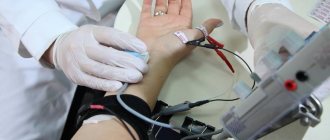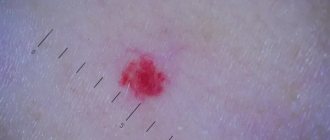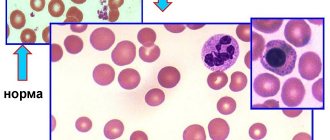Why do my legs and arms go numb? What diseases can lead to these symptoms? Which doctor should I contact? How to diagnose the cause?
Numbness in the arms and legs is a neurological symptom that most often indicates damage, inflammation, or compression of sensory nerves. Often, numbness is accompanied by pain and unpleasant sensations such as tingling and “crawling goosebumps.” Many nerves are mixed, that is, they contain both sensory and motor fibers. In such cases, numbness is combined with a decrease in muscle tone and impaired movement.
There are many reasons for numbness in the limbs. Most often they are associated with pathological processes in peripheral nerves. The larger the nerve, the larger part of the limb loses sensation. In rare cases, the symptom is caused by disorders of the brain and spinal cord.
Numbness from compression of nerves and nerve roots
One of the most common conditions that leads to compression of the nerve roots is intervertebral hernia. Most often it forms in the lumbar spine, as it experiences the heaviest loads. Fortunately, in most cases, if you consult a doctor in a timely manner, intervertebral hernias can be treated without surgery.
Carpal tunnel syndrome leads to numbness, tingling in the hand and other symptoms. In the wrist area there is a tunnel formed by bones and ligaments. It contains a nerve that, under certain conditions, can be compressed.
In the area of the shoulder girdle and collarbone is the brachial nerve plexus - all the main nerves innervating the arm depart from it. During injuries (most often road accidents), these nerves are stretched and compressed, resulting in numbness and, in severe cases, paralysis of the arm.
With spondylolisthesis, the upper vertebra “slips” a little from the lower one, this leads to compression of the spinal cord and nerve roots, and sensitivity disorders.
External reasons
It’s good if your hands go numb during sleep due to unstable air temperature in the bedroom. Once this situation is corrected, the sensations will disappear. Parasthesia may occur due to the fact that the pillow or bed is chosen incorrectly or the person suffers from bad habits.
High headboard
Getting carried away by dense pillows when your head lies high, you can get a deflection in the cervical spine. This situation leads to the fact that the roots of the nerve endings passing along the spinal cord are poorly supplied with nutrition. In the areas of the spine responsible for sensitivity and mobility of the limbs, blood flow worsens.
To get rid of cramps, replace the pillow with an orthopedic version or place a cushion under the neck. Sleep items are made taking into account the anatomical features of the head and neck. Thanks to this, blood flows evenly to all parts of the spinal column.
Body position
Your sleeping position is important so that your hands do not lose sensitivity in the morning. When a person sleeps on his side, he lies on his hand, pinching the vessels in it. The blood begins to stagnate, leaving the hand and fingers without nutrition. The heart works slowly at night, so it is unable to deliver blood to hard-to-reach areas of the body.
Loss of sensitivity is caused by throwing your arms behind your head while lying on your back. Tight pajamas, nightgowns with long sleeves, when tight seams squeeze the blood vessels in the arms, contribute to the swelling of the limbs.
Control of body position is difficult to achieve at night. But you need to accustom yourself to the correct sleeping position so that all parts of the spine are in a straight line. Sleepwear is chosen from breathable natural materials. Women are advised to remove all jewelry from their fingers and wrists to avoid squeezing blood vessels.
The median nerve may be pinched by tight cuffs
Lifestyle
Evening consumption of coffee, strong tea, and alcoholic beverages leads to the fact that a person sleeps poorly. After all, at first the vessels are dilated, but at night they sharply narrow. Hence the occurrence of headaches and intestinal disorders. Starting to toss and turn in their sleep, people take an unnatural position, which is why their hands begin to go numb.
Hands cramp if:
- work at the computer for a long time;
- lead a passive lifestyle;
- physically load the spine during training and hard work;
- Raise their hands up during professional activities throughout the entire shift (installers, painters).
The nerves in the limbs are temporarily compressed when they draw or write for a long time.
Vascular disorders
One of the complications of diabetes is diabetic neuropathy, damage to sensory, motor and autonomic nerves as a result of impaired blood flow in small vessels. One possible symptom is numbness in the limbs.
There is a large group of diseases - vasculitis. Autoimmune inflammation develops in the vessel wall, it thickens, becomes weakened, and scarring occurs. In the lumen of the vessel, areas of narrowing appear in which blood flow is disrupted. Various organs, including nerves, can suffer from this.
With one of the systemic connective tissue diseases - Raynaud's disease - a spasm of the small vessels that supply blood to the fingers and toes occurs. In response to cooling or stress, a feeling of coldness and numbness occurs in the fingers.
Wrong lifestyle
Smoking, alcohol abuse, and poor diet can lead to numbness in the limbs. If you take spicy foods, strong coffee or black tea, or alcoholic drinks at night, this will lead to pain in the epigastric region and head. As a result, during sleep the body will take a forced position, in which health will improve. Since changing positions during sleep occurs instinctively and is not always convenient, this can contribute to the appearance of paresthesia. In the morning, after half a minute, the sensations go away on their own.
Diseases of the brain and spinal cord
One of the most common causes of numbness in different parts of the body associated with brain damage is a stroke, as well as a transient ischemic attack, which is popularly called a “mini-stroke”. Severe injuries to the brain and spinal cord can lead to sensory impairment.
Less common are such lesions of the central nervous system as an aneurysm (a pathologically enlarged, weakened area) of a cerebral vessel, arteriovenous malformation (incorrect communication between an artery and a vein, when blood is discharged directly, bypassing the network of capillaries), tumors of the brain and spinal cord, paraneoplastic syndrome ( damage to the nervous system caused by a tumor that is located outside the brain).
The article lists only the main common causes of numbness in the arms and legs. There are others. In order to get an accurate diagnosis and begin proper effective treatment, you need to visit a doctor.
What is the difference between the appearance of a symptom in the right and left hand?
Some diseases cause discomfort in both hands. But more often, due to various diseases, a certain hand goes numb:
- The causes of numbness in the left hand
may be disturbances in cardiac and vascular activity. In some cases, unpleasant tingling sensations indicate an impending myocardial infarction or stroke; - numbness in the right hand
indicates an uncomfortable body position during night sleep, carpal tunnel syndrome, and inflammatory joint diseases. Less commonly, the symptom is associated with a pre-infarction condition.
Who should I contact?
A neurologist is involved in the diagnosis and treatment of neurological disorders, such as sensory loss and numbness in the extremities. In order to correctly assume what was the possible cause and choose the right direction of the diagnostic search, the neurologist must examine the patient, find out in which parts of the body numbness occurs (only in the fingers, in the hands or feet, in the entire arm or leg, in one limb , or right and left symmetrically), are there any other neurological symptoms or concomitant diseases.
Depending on the results of the examination, the neurologist may refer you to other specialists:
- For vasculitis, Raynaud's disease - see a rheumatologist.
- For cardiovascular pathologies, see a cardiologist.
- For diabetes mellitus, see an endocrinologist.
- In case of tumors or injuries, see a neurosurgeon.
- For infectious diseases - see an infectious disease specialist.
- In case of poisoning with harmful substances at work, contact an occupational pathologist.
When one hand goes numb
A feature of parasthesia of the extremities is that both arms or only one may become numb. It happens that in the morning the sensitivity of several fingers is lost. When your right hand suffers at night, you need to pay attention to the sleeping position. By squeezing your hand with your body, the blood vessels are compressed, and tissue nutrition is stopped.
A leak occurs on the right side if the inflammation covers the cervical spine. After arm fractures, disturbances occur in the structure of blood vessels and tendons. This is why numbness occurs in the hands. Long-term loss of sensitivity, when the left side suffers, indicates developing or current heart disease.
Before an attack of angina pectoris, the hand and forearm become numb. You should call an ambulance if numbness begins on the entire left side of the body. This is a symptom of a stroke. An impending heart attack will be accompanied by severe pain in the heart area. Creeping and burning indicate atherosclerosis of the left brachial artery. With thrombosis, the affected area loses sensitivity, is very painful, and swells.
Examination for numbness of extremities
- Depending on the suspected cause of numbness in the limbs, the doctor may prescribe different types of diagnostics. X-rays help diagnose diseases associated with disorders of the skull and spine, such as intervertebral hernia. If there is a suspicion of vascular pathology, angiography is performed - an X-ray examination with the introduction of a contrast solution into the vessels.
- If necessary, you may be prescribed other imaging methods: ultrasound, CT, MRI.
- In order to check in which nerves the conduction of impulses is impaired, electroneuromyography is used - a study using special electrodes.
- Sometimes they resort to the method of evoked potentials. Special sensors are placed on the patient's head to record brain activity. The affected nerve is stimulated through the skin using electrical impulses and the brain is observed to respond to the stimulation.
Since dozens of different reasons can lead to numbness in the arms and legs, the diagnostic program must be individual for each patient. In some pathologies, if left untreated for a long time, even more serious, irreversible neurological disorders may occur. Visit a neurologist, make an appointment by phone: +7 (495) 120-08-07
Treatment
Pre-hospital assistance
In case of numbness due to neurological diseases, it is necessary to exclude loads that provoke an increase in symptoms, and take regular breaks to rest the hands. In case of traumatic injuries, the injured segment of the limb should be fixed or the victim with a spinal injury should be placed on a backboard and given an anesthetic. Increasing swelling, intense pain, followed by numbness of the limb, are reasons for immediate contact with a specialist.
Conservative therapy
The treatment regimen for neurological causes of hand numbness includes the following areas:
- Pain relief
. Drugs from the NSAID group are used; in case of severe pain, a blockade is performed with an anesthetic or a mixture of an anesthetic and a corticosteroid drug. - Normalization of muscle tone
. Tolperisone, methyllycaconitine hydroiodide, and baclofen are effective in reducing muscle tone and eliminating spasms. - Improving blood circulation
. To improve blood supply and stimulate venous outflow, pentoxifylline, aminophylline, and troxerutin are recommended.
Patients are prescribed B vitamins and diuretics to eliminate edema. According to indications, the treatment plan is supplemented with chondroprotectors. Chronic pain may require antidepressants. The list of non-drug methods includes ultraphonophoresis, UHF, hydrotherapy, therapeutic mud, ozokerite and paraffin applications. An important role is given to massage, exercise therapy, manual therapy, and reflexology.
For Takayasu's disease, immunosuppressants, antiplatelet agents, and anticoagulants are recommended. Plasma cascade filtration, lymphocytapheresis, and plasmapheresis are performed. For thromboangiitis, antispasmodics, NSAIDs, and agents to improve the rheological properties of blood and activate local metabolism are used. They give a referral for ILBI, hyperbaric oxygenation, hemosorption.
Surgery
The tactics of surgical intervention are determined by the nature of the pathology that provoked numbness of the hands. Neuralgia due to nerve compression by a tumor, scars, fibrous or bone growths are considered as an indication for neurolysis, tumor removal or decompression intervention.
For spinal pathologies, discectomy, scoliosis correction, and operations to eliminate spinal stenosis and instability of the spinal column are used. The cause of brachial plexitis is eliminated by removing cervical ribs, excision of tumors and aneurysms, and correcting the position of fragments in fractures.
How it manifests itself
When your hands begin to numb regularly in the morning, a conscious person seeks to find out the cause of this trouble.
This can only be done in a doctor's office. The complaint of temporary loss of sensitivity is most often heard by a neurologist, to whom a vigilant therapist refers the patient. The most important thing in this case is to establish the correct diagnosis. To do this, you need to tell the doctor what symptoms are accompanied by morning numbness of the hands:
- partial or complete loss of sensation at the tips of the phalanges of the fingers or throughout the entire limb - from the shoulder to the nails;
- a feeling of “goosebumps” crawling across the skin;
- convulsions;
- a feeling of tingling and burning;
- throbbing pain;
- muscle spasms;
- slight trembling;
- freezing;
- abnormal skin pallor;
- numbness with pain syndrome.
As already mentioned, sensitivity disorders of the right and left hands can be provoked not only by some external factor. Many systemic pathologies and organ diseases also manifest themselves as numbness of the upper extremities in the morning. That is why it is necessary to consult a doctor if one, or even more so, several of the symptoms listed above begin to bother you regularly.
You need to consult just in case, even when your hand goes numb just once. Better to play it safe.
Diagnostics
How to treat numbness in hands? Therapeutic tactics depend on the etiology of the process, which means it is very important to make the correct diagnosis before starting therapy. It is necessary to contact a neurologist, but consultations with doctors of other specialties may be required: orthopedist, traumatologist, vascular surgeon, therapist, endocrinologist, rheumatologist.
A survey and neurological examination of the patient is complemented by:
- electromyography;
- electroneurography;
- radiography of the spine, upper limb;
- Magnetic resonance imaging;
- Doppler ultrasound of the vessels of the upper extremities;
- laboratory examination (detailed clinical, biochemical blood test).











